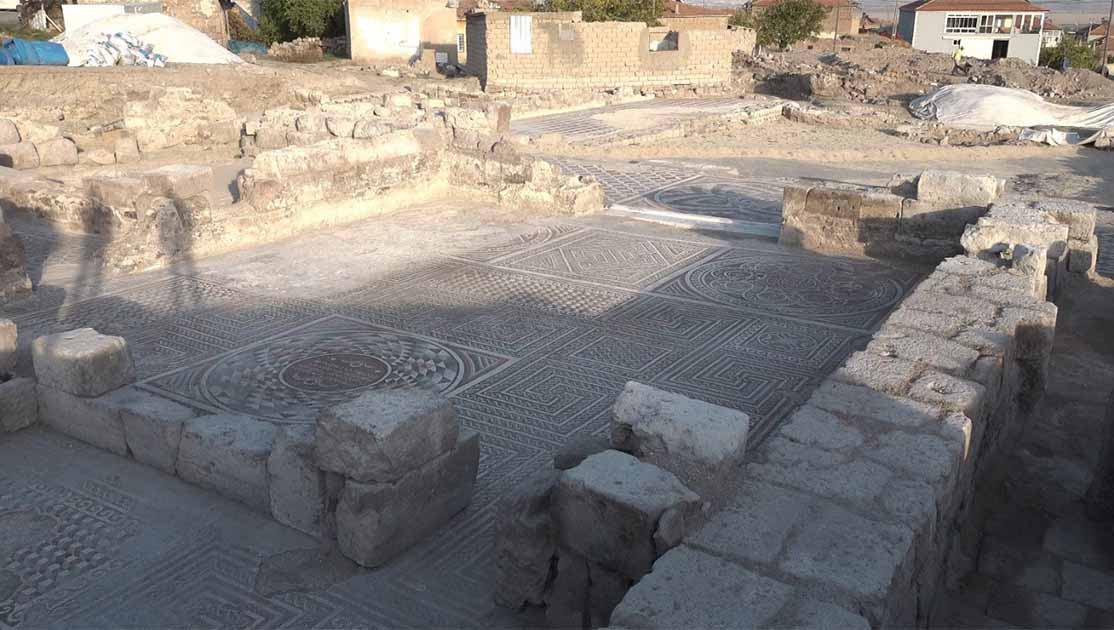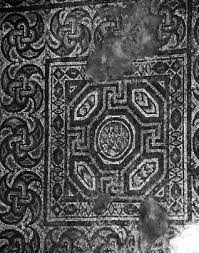
A massive ancient mosaic with Latin and Greek inscriptions was uncovered in Cappadocia during excavations of a fourth-century villa in Örenşehir District of İncesu district of Kayseri province, located in the center of Turkey.
These intricate artworks, spanning an impressive 600 square meters, offer a fascinating glimpse into the opulent past of this region.
The Kayseri Provincial Culture and Tourism Director, Şükrü Dursun, revealed that the ongoing excavations in the İncesu district, which kicked off three years ago, have yielded remarkable results.
At the same time, he expressed plans and hopes to continue work next year.
Mosaic in Cappadocia an Astonishing 600 Square Meters
Over the past three years, diligent efforts have led to the unearthing of various areas within this ancient villa. Notably, the mosaic area, initially estimated at three hundred square meters, has now expanded to twice that dimension to six hundred square meters.
This expansion attests to the sheer scale and grandeur of the villa. Dursun’s statements provide a glimpse into the villa’s historical timeline. Based on findings, it is believed the villa was constructed in the fourth century.
However, excavations have also uncovered traces dating back to the third century and beyond. The quality of craftsmanship evident in the floor mosaics suggests that this villa held great importance in its time.
Perhaps one of the most captivating aspects of this excavation is the discovery of inscriptions within the villa. Among these is a Latin inscription found in what is presumed to be the reception hall.
The Latin inscription reads:
Votis XXX multis XX bis XX
Curante Yacintho comite
Fabrica ad summum per
Ducta es culmen
This can be interpreted as:
With vows/prayers on the occasion of the 30th anniversary and further vows until the 40th
[The building was erected] Under the direction of the comes Hyacinthus
You, building, have been executed to the highest level.
Another much briefer inscription in a smaller adjacent square room is in Greek and translates to “if you are healthy, enter.” This could refer to either physical health, or, if the building had a religious purpose, it could be a condition that all who were allowed to enter the space were spiritually sound.

These inscriptions offer a tantalizing glimpse into the cultural and linguistic diversity of the villa’s inhabitants.
Largest Byzantine #mosaic structure found in central #Anatolia #Turkey: 300 square meters (3,330 square feet) of mosaics from the late #Roman-early Byzantine period in central #Kayseri province’s Incesu districthttps://t.co/oB04cS9SGh pic.twitter.com/NzoRpGSPKU
— Sarah (@Sarah404BC) October 28, 2021
Mosaics Demonstrate Villa’s Opulence
The mosaics themselves are a testament to the villa’s opulence and aesthetic sophistication. They predominantly feature intricate geometric patterns and ornaments, showcasing the artistic prowess of the craftsmen who once worked here. Each mosaic tile serves as a pixel in a larger picture, conveying stories and cultural elements from a bygone era.
The significance of this archaeological site extends beyond its past. Can Erpek, a lecturer at Nevşehir Hacı Bektaş Veli University and head of the excavations, said that the villa appears to have remained in existence through the Byzantine era and even beyond the arrival of the Turks in Anatolia.
This sprawling residence, boasting approximately thirty-three spaces, remains unparalleled in Central Anatolia, particularly in the Cappadocia region. The inscriptions, including the name ‘Hyacinthos,’ imply that this was a high-ranking official’s residence, and Erpek hopes the data will clarify just this.
Greek presence in Cappadocia
The Greeks of Cappadocia in central-eastern Anatolia created their own flourishing culture in ancient times, and it thrived in the region for millennia.
Once home to a Greek population that established trade ties there beginning as far back as 1,300 BC, Cappadocia, located in modern-day Turkey, still contains traces of the brilliant Byzantine-era culture of Asia Minor Greeks. This includes churches and nearly-complete underground cities.
Cappadocian populations included the Hittites, whose Indo-European languages, such as Phrygian, were closely related to Greek in some cases. However, due to the burgeoning Greek influence there, all inhabitants of the area became entirely Greek-speaking by at least the late Roman period during the fifth century AD.
See all the latest news from Greece and the world at Greekreporter.com. Contact our newsroom to report an update or send your story, photos and videos. Follow GR on Google News and subscribe here to our daily email!



